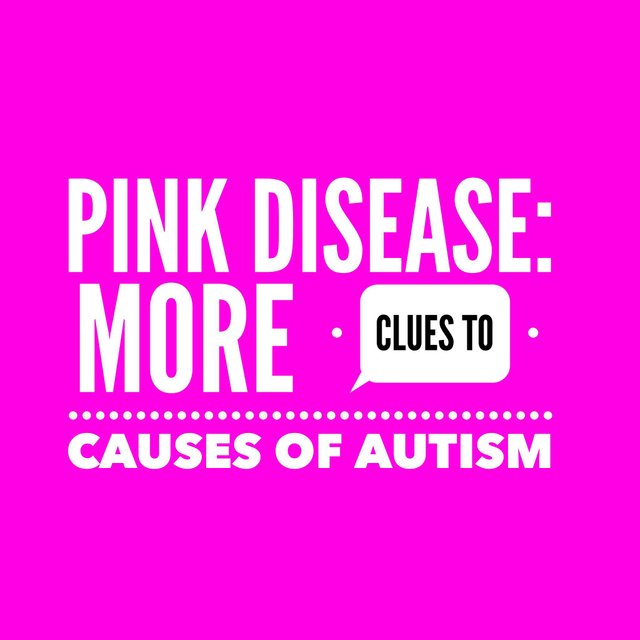Pink Disease, Mercury & links to Autism
I paid a house call to a cancer patient yesterday [already mentioned here] and learned he was a victim of Pink Disease as a baby. He mentioned it because he suffers with bronchiectasis. 30% of Pink Disease babies end up with bronchiectasis.

Infantile Acrodynia aka Pink Disease
Teething powders & worming preparations caused Pink Disease in 1:500 [not all] of the children exposed to them in the first half of the C20th.
It was thought that affected children had a hypersensitivity to mercury and a study has since been done to see if this extended to higher rates of ASD in survivors' descendants. It was found to be the case with a 1:25 incidence of ASD in descendants compared to [a then current] 1:160 incidence of ASD in the general population. [This research was carried out in 2011 and current rates are 1:68]
Pink Disease & Autism:
The association between the symptoms of Pink Disease and autism were obvious to me as soon as I read them. They are detailed here as follows:
"In reading ... early descriptions of infants and young children diagnosed with Pink Disease there are numerous overlaps between Acrodynia and autism. These include:
- depression,
- apathy,
- fretfulness,
- loss of appetite,
- social withdrawal,
- photophobia
- sweating,
- hypotonia,
- misery,
- slurring or loss of speech,
- insomnia.
- Hand banging,
- rocking,
- parasthesias in the extremities,
- occasional tremor,
- convulsions and
- gastrointestinal disturbances."
In 1945 when 12 of 14 children diagnosed with Pink Disease were found to have elevated mercury levels, mercury preparations like teething & worming powders were gradually banned.
"Pink Disease was and still is a very nasty disease with diverse and complex symptoms ... the age of onset is usually between 6-14 months. The most common cause of Pink Disease was teething powders containing mercurous chloride (calomel). ."
Pink Disease Symptoms.
I follow with a more comprehensive list of Pink Disease symptoms from the PDF linked above:
"The symptoms of classic Pink Disease for babies and toddlers [mercury poisoning symptoms] include:
- An itchy, burning rash
- Hair pulling and/or loss of hair
- Skin that peels off in layers
- Teeth loosen and/or fall out
- Photophobia (extreme light sensitivity)
- Convulsive seizures and petit mal attacks
- Muscle weakness and flaccidity (atonia)
- Elevated temperature, blood pressure and pulse rate
- Clumsiness (ataxia)
- Excess salivation
- Digestive problems including loss of weight, loss of appetite, vomiting and constipation
- Enlarged lymph glands
- Cold, clammy, swollen pink or bluish hands and feet
- Low blood sodium level
- Scratching and tearing at skin and sucking and chewing of fingers
- General excess sensitivity of the skin to touch, temperature, water and UV light
- Anaemia
- Excess nasal discharge
- Profuse sweating
- Abnormal skin and muscle sensations
- Ulceration of the gums
- Numbness of the extremities
- Insomnia
- If circulation is really poor in the extremities, gangrene and auto-amputation can occur
- The child is restless, irritable, miserable & anxious
- Secondary infections particularly to the skin and lungs
The disease typically lasted between 3 months and a year and it sometimes recurred." [the duration of the teething treatment]
"Pink Disease occurred in older children in Europe because the most common cause was worming preparations containing mercury.
The symptoms of Pink Disease in children over the age of 2 are similar to those mentioned above but are nowhere near as dramatic - ·
- Irritability,
- failure to gain weight,
- sleeplessness and lack of energy are the most noticeable symptoms. ·
- Light sensitivity and the pinkness of the hands and feet are not as noticeable. ·
- Coldness and moistness of the extremities is evident. ·
- Lack of muscle tone and high blood pressure are detectable. ·
- The child becomes listless, doesn’t smile, and doesn’t want to play anymore and may simply sit around and rest all day.
- The older child can become asocial, talk infrequently and be bad tempered, difficult and even violent."
[source: downloads a PDF]
These 'older child' symptoms are particularly akin to autistic spectrum disorder symptoms.
This further supports our sense that autism is linked to mercury [and other metal] toxicity, affects children who have a hypersensitivity to mercury [and other toxic metals], perhaps because they are unable to detox them fast.
Most mercury has been eliminated from vaccines [exceptions are multi-dose flu vaccines in particular] and it will be interesting to see if autism rates stabilise now that mercury is removed. I'm not convinced, since I'm seeing children who regressed after vaccines despite the removal of mercury. Their parents will be mercury toxic most likely, from vaccinations and from dental amalgams.
Mercury will not be the only culprit. Also, aluminium adjuvants in vaccines, paired with poly sorbate 80 [which opens the blood-brain barrier] will be a significant metal toxicity issue for susceptible children [like those with particular MFTHR mutations, ie.]
To all parents and homeopaths reading: this confirms that mercury is even more significant in autism than you already thought.
Very interesting well written and presented. Just great.!
Wow thanks @lilllygreen 😄
This was a great read. You learn something new everyday. Thanks. 💎💎💎
Welcome.
Waw, thanks Sally.
Welcome.
@alanfreestone. What do you think?
@sharingeverybite tagging you as you may be susceptible to mercury sensitivity like this. This can also be a source of your toxicity is you are a descendent if someone poisoned in this way.
X